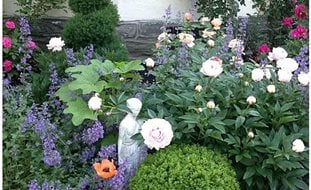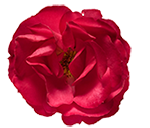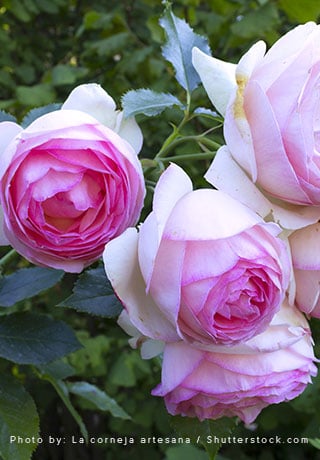Ideas for Designing a Rose Garden
Create a beautiful rose garden for your front or back yard, small or large garden, and learn what to plant with rosesAs one of the world’s most beloved garden plants, roses deserve a prominent spot in the landscape. While these long-lived shrubs have a reputation of being somewhat fussy, newer cultivars bred for disease-resistance and vigor have made growing roses easy for even novice gardeners.
A rose garden can be as simple as a single rose specimen interspersed with a few other plants. It can be as elaborate as a formal landscape embellished with hardscaping, arbors, seating, and statuary. Even smaller spaces can accommodate roses in containers, raised beds, or narrow side yards. Here are the basics of rose garden design, along with some ideas to get you started.
On this page: Planning | Different Spaces | Landscaping Tips | What to Plant With Roses | Design Ideas | More Rose Gardens | Related Reading
On this page:
- PLANNING A ROSE GARDEN
- ROSE GARDENS IN DIFFERENT SPACES
- ROSE GARDEN LANDSCAPING TIPS
- WHAT TO PLANT WITH ROSES
- ROSE GARDEN DESIGN IDEAS
- MORE ROSE GARDENS
- RELATED READING
PLANNING A ROSE GARDEN
Choose your site:
Make sure the site gets at least 6-8 hours of sun a day and has good air circulation to help prevent disease.
Make a plan:
- Gather ideas from books and online sources for inspiration.
- Draw up a rough sketch as you’re brainstorming to help visualize what the finished garden will look like.
- Include pathways for easy access.
- Beds should be small enough to allow for pruning and other maintenance chores.
- Consider structures such as pergolas, arbors or trellises, as well as seating and decorative accents.
Choose a style:
Decide what kind of rose garden you want. Do you want a clean formal look with structured hardscape, or a more natural appearance with other plants mixed in? Pick a style that will harmonize with your home’s exterior.
Pick a color scheme:
Select colors that you enjoy and that will also help unify the home with the landscape.
Prepare the soil:
Roses like rich, well-draining soil with a slightly acidic pH between 6.0-7.0. Amend the soil with compost or other organic matter. For containers, use a high quality all-purpose potting soil and make sure pots have adequate drainage holes.
Plant selection:
Choose roses that are easy-care and hardy in your region. Select varieties for traits including size, shape, flower color, and form, fragrance and repeat or continual bloom. Many newer varieties such as Oso Easy Roses are bred for disease-resistance, vigor, and long bloom time. Some older types, particularly hybrid teas, can be higher maintenance and more disease-prone.
CREATE A ROSE GARDEN IN DIFFERENT TYPES OF SPACES

Plant fragrant rose varieties near a deck or patio to enjoy their fragrance up close. Gardener: Diana Gough. Designer: Phil Thornburg. Photo by: Janet Loughrey.
Large rose garden:
- Create a design with formal rooms or mixed borders that are grand in scale so it doesn’t get lost in the surrounding landscape.
- Keep scale in mind when adding hardscape, seating and structures such as arbors and pergolas, which are typically included in rose gardens.
- Choose larger rose varieties that will show up better in the landscape.
- Plant in drifts of 3 to 5 specimens of the same variety for greater visual impact.
- Plant larger groupings with the same flower color for a more unified look.
Small rose garden:
- Choose smaller rose varieties that will stay in scale with a more intimate space.
- Maximize the use of space by including vertical elements such as climbing roses and trellises.
- Select a few key rose specimens rather than trying to crowd in a lot of different varieties.
- Limit the color scheme to one or two hues so the design doesn’t look too busy.
- Choose roses with lighter colored flowers in hues of white or yellow to make the space look larger and brighter.
Front yard rose garden:
- Leave plenty of room around rose plants so they don’t crowd sidewalks or other trafficked areas.
- Don’t allow plants to obstruct entrances or doors so visitors don’t get scratched by thorns.
- For foundation plantings, allow enough distance between shrubs and the home’s facade to provide adequate air circulation.
Backyard rose garden:
- Include seating areas in different parts of the yard, which will encourage you to spend more time enjoying your rose garden.
- Site the rose garden where you can enjoy it from inside the home.
- Plant fragrant rose varieties near a deck or patio where you can enjoy the sweet perfume.
- Place a bench, water feature, or statuary at the far end of the rose garden to draw the eye through the landscape and encourage visitors to wander and linger.
ROSE GARDEN LANDSCAPING TIPS

Create a grand entrance to your home with a rose-covered arbor. Gardener: Mary DeNoyer. Photo by: Janet Loughrey.
Grow vertically:
Include climbing roses to maximize your space. Train other vining plants such as clematis to grow up through shrub or climbing roses to create exciting flower combinations.
Grow horizontally:
Train climbers along a fence to define garden rooms or to soften an unsightly chain link fence.
Plant in containers:
Many roses can be successfully grown in containers, a good solution for small spaces, apartment balconies, patios, and decks. Containers should be at least 15 to 20 inches in diameter and 18 to 24 inches deep. Half whiskey barrels work well. Miniature roses can be grown in smaller pots or hanging baskets. (See more on growing roses in pots.)
Cover a slope:
Mass groundcover varieties such as Flower Carpet® or Drift® roses along a slope for low-maintenance erosion control.
Plant in drifts:
For greater impact, plant in groups of 3-5 specimens of the same variety.
Plant a hedge:
Plant a row of taller shrub roses to create privacy from the street. A row of shorter groundcover roses can be planted along a foundation, in a curbside strip, or used to define garden areas.
Make an entrance:
Create a grand entrance to your home with an inviting entryway complete with a rose arbor and adjacent plantings to soften the landscape.
Create a transition:
Use a rose-covered arbor in a side yard to define the transition between front and back yards.
Use as a background planting:
Place climbers along a tall wooden fence to soften the backdrop and break up the expanse of wood.
Foundation planting:
Combine landscape roses with other shrubs that bloom at different times along the front of your home for a season-long display of color.
Mixed border:
Use low-growing ground cover roses near the front of a mixed border or taller semi-climbers in back to establish height and layers.
WHAT TO PLANT WITH ROSES

A curbside planting of roses underplanted with perennial geraniums offers screening and privacy. Garden and photo by: Janet Loughrey.
A rose garden can be greatly enhanced by incorporating other plants as part of the overall design. Roses go well with a wide variety of trees, shrubs, perennials and annuals. Choose plants that have the same cultural requirements of full sun, ample water and rich soil.
Also, consider how much maintenance your roses will need:
- Hybrid teas, grandifloras, floribundas, climbers, and miniatures all require regular maintenance and pruning, as well as winter protection in cold climates. Companion plants should be confined to in front of or behind roses, not in between them, to allow easy access.
- Species, shrub, old garden, and landscape roses require only minimal maintenance: cleaning up in winter and deadheading as needed when in bloom. These types of roses can be surrounded with perennials, annuals, bulbs, and shrubs.
Flowering companions:
Intersperse plants that flower at different times to extend the bloom season. These can include perennials or annuals such as petunia, verbena, or calibrachoa.
Complement and contrast:
Pair roses with other plants in complementary hues to create drama and contrast. A gold-colored rose such as Oso Easy Lemon Zest® would pair well with Rapido Blue Carpathian bellflower or ‘Violet Profusion’ salvia.
Trees:
Add different heights to a mixed border or formal rose garden with trees. These can include snowbell (Styrax japonicus), fringe tree (Chionanthus virginicus), dogwood (Cornus) and crabapple (Malus).
Shrubs:
Enhance the landscape by providing contrasting color, texture, and structure with shrubs. These can include boxwood, spirea, bluebeard, and daphne.
Groundcovers:
Use groundcovers as a living mulch and weed-suppressing carpet. Good rose companions include perennial geraniums, dead nettle, bugleweed, and lady’s mantle.
Perennials:
Provide contrast with perennials of different size, structure, and color. Good rose companions include alliums, lavender, catmint, salvia, phlox, and speedwell.
Vines:
Climbers can be trained up or alongside rose plants for an extra layer of color. These may include clematis, climbing bleeding heart (Dicentra scandens), morning glory and jasmine.
For more: What to Plant with Roses: 20 Plants.
ROSE GARDEN IDEAS

Plant fragrant rose varieties near a deck or patio to enjoy their fragrance up close. Gardener: Diana Gough. Designer: Phil Thornburg. Photo by: Janet Loughrey.

Combine roses with other plants of different heights for a layered tapestry. Gardener: Jeff Clark. Photo: Janet Loughrey.

A formal rose garden is characterized by distinct lines, clipped hedging and structures such as pergolas and arbors. Gardener and designer: Nancy Cutler. Photo: Janet Loughrey.

A rose-covered gate marks the transition between the front and back yards. Gardener: Mary DeNoyer. Photo: Janet Loughrey.

Train roses vertically to add varying layers to the landscape. Gardeners: Darin Simmons and Matthew Greydanus, Laurel Hedge. Photo: Janet Loughrey.

Train climbing roses along a fence to create an attractive screen for privacy. Gardeners: Danny Hills and Wayne Hughes, Lonesomeville Gardens. Photo: Janet Loughrey.

Roses combine well with many perennials, shrubs, trees, and annuals. Photo: Matthewshutter / Shutterstock.
MORE ROSE GARDENS

In this front garden, perennials such as catmint, delphinium, and hollyhocks mingle with roses.

See this backyard that was transformed into a spectacular rose garden featuring David Austin roses.

Another public rose garden, features over 10,000 rose plants from 550 species.












